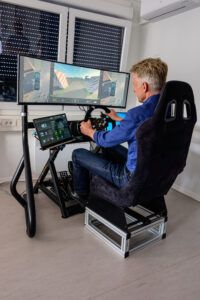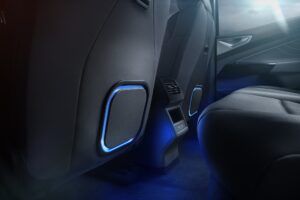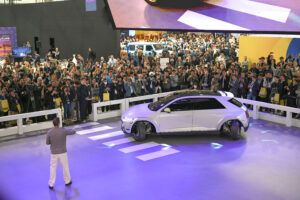Artificial Intelligence, in-car entertainment and software-defined vehicles all proved hot topics at this year’s Consumer Electronics Show in Las Vegas, cementing the fact that cars are rapidly becoming extensions of our digital lives. Here’s a look at the automotive tech highlights from the Sin City show floor, and trends we can expect to see in the very near future.
Automotive manufacturers previously saw the Consumer Electronics Show as an excuse to future-gaze, producing headline-grabbing concept vehicles specifically for the week-long show that rarely ever saw the light of day once the crowds had subsided.
But there has been a monumental shift in the way technology now plays a starring role in modern vehicles, particularly those powered by alternative fuel sources, and automotive brands feel very much at home among the augmented reality headsets, advanced gaming tech and artificial intelligence assistants so often found on the show floor of the Las Vegas Convention Center – because much of it will appear in vehicles over the next few years.
With that in mind, this year’s event saw a return to pre-Covid levels of interest and as a result, there was plenty of enticing tech to get stuck into.
 Honda 0 Series
Honda 0 Series
Although Honda once again reaffirmed its ties with Sony, wheeling out a tweaked version of its Sony Honda Mobility-branded Afeela EV, it also took the opportunity to announce a refreshed vision of its all-electric future.
The 0 Series Sedan and Space Hub were essentially the result of the Japanese brand ripping up its existing EV rulebook and returning to “the starting point of Honda as an automaker,” according to Global CEO Toshihiro Mibe.
The two vehicles previewed a new “thin, light and wise” philosophy that will incorporate the next generation of skinnier and lighter battery packs to allow for EVs, particularly in the Saloon’s case, to sport much sleeker styling and ride much lower to the ground.
We are likely to see an iteration of the Saloon hit roads first, as it is tipped to spearhead a range of new EVs that will ride on a bespoke electric architecture and arrive in 2026.
Full specification and performance figures are still some way off, but Honda is aiming for Level 3 automated driving, faster charging times (15 to 80 per cent top-ups in around 10-15 minutes) and a focus on putting the fun back into the driving experience.
 Kia’s Platform Beyond Vehicles
Kia’s Platform Beyond Vehicles
The commercial vehicle market is perhaps a little too vanilla for a CES crowd, which goes some way to explain why Kia pulled out all the stops with its ‘Platform Beyond Vehicle’ business. Manifesting itself in the Kia PV5, which will be the first electric commercial vehicle from the South Korean brand to grace our roads in 2025, it will be followed by the smaller PV1 and PV3, as well as the larger PV7.
Riding on a specially adapted version of the E-GMP platform, the PV5 will measure up against the upcoming electric Ford Tourneo Custom and will be offered in a variety of cab and cargo area styles, ranging from seating for taxis, to modular load space that’s designed to appeal to small to medium businesses.
The Platform Beyond Vehicle moniker is in reference to the fact that Kia wants to promote a more flexible manufacturing process that allows for customers to specify exactly what they want from the cargo space. Looking ahead to the future, the brand plans to create fully modular commercial vehicles that can have the rear load space lifted from the chassis and autonomously swapped out, so it can effectively transform from a carrier of goods to a transporter of people in a matter of minutes.
Admittedly, this is all bordering on the conceptual for now, but Kia is adamant its constantly connected commercial vehicles will be able to seamlessly integrate with fleet management software, without the need for additional technology, as well as form the perfect platform for autonomous ride-hailing services in the future. It has already signed a Memorandum of Understanding (MoU) with Uber to develop its PBV business in the ride hailing space.
 BMW Teleoperated Valet Parking
BMW Teleoperated Valet Parking
Although lacking any new or particularly striking EV concepts, BMW showcased several technological advancements at this year’s show. The first is a joint project with autonomous driving specialist Valeo, which allows for next-generation automated Level 4 parking, as demonstrated by an iX that was cruising around the parking lot of the Las Vegas Convention Center without a driver behind the wheel.
Dubbed Teleoperated Valet Parking, the system harnesses existing sensor and camera tech in the car and allows an operator to remotely manoeuvre and park the vehicle via a simple gaming peripheral set-up of steering wheel and pedals. All the tech requires is a stable 4G or Wi-Fi connection for data transfer and software.
The BMW iX is limited to a walking pace when in the remote parking mode, but the operator has full control of steering and limited amounts of throttle, as well as BMW’s existing fully autonomous parking modes.
The idea being that BMW owners will soon be able to pull up multi-storey car parks, hotels and other facilities running the system, hop out and have an operator in a remote location park the car for them. It’s a ‘stop gap’ between fully autonomous parking modes that BMW says can be implemented in the coming year.
 MBUX Sound Drive
MBUX Sound Drive
Software is rapidly becoming the next hotly contested market, as automakers battle to come up with novel ideas that stand their vehicles out from the infotainment crowd. Mercedes-Benz, thanks to help from pop star will.i.am, offers one such solution in MBUX Sound Drive.
Here, a dedicated app takes deconstructed versions of popular songs and then lets driver inputs remix and reproduce the tracks, offering a live music experience where no two ‘performances’ are the same. It’s the brainchild of will.i.am and his team of talented developers.
During a demonstration in the marque’s EQS electric model, we witnessed The Black Eyed Peas’ I Gotta Feeling gradually come to life, with throttle inputs bringing in bass notes, steering inputs adding vocals and instruments, and acceleration encouraging the track to a rousing crescendo, before changing form and dying back to an ambient backing track when stopped or stuck in traffic.
Mercedes-Benz says it’s a “ground-breaking interactive music experience” that offers an alternative soundtrack to the often audibly bereft EV experience. An over-the-air update coming later this year will see the Sound Drive app added to any vehicle equipped with the latest generation of its MBUX infotainment system, even those with engines. Although it is still unclear what the cost to the end user will be.
 Harman SeatSonic
Harman SeatSonic
Interior and infotainment specialist, Harman, offered a few new concepts at this year’s show, including SeatSonic, which moves vehicle speakers from conventional locations in door cards and dashboards into the seats.
Harman says the all-in-one package frees up space for interior trim designers and reduces overall weight, while the power consumption of its SeatSonic system is 60 per cent lower than a conventional in-car audio set-up. This metric is important when considering modern EV makers are always striving for more efficient battery consumption.
The unit sees near-field transducers integrated into the headrests and a proprietary bass unit in the lumbar section of the seats for a visceral low note experience. The most basic package involves just the seat/speaker set-up, but Harman will also offer a more engaging (and premium) listening experience with additional tweeters mounted below the windscreen.
Working alongside Tier 1 seat suppliers, as well as wellness specialist Gentherm for massaging functionality, Harman says it can offer an off-the-shelf solution to suit most manufacturers.
 Hyundai Mobis Mobion
Hyundai Mobis Mobion
Demonstrating hardware that could banish tricky parking situations to the history books, Hyundai Mobis – a parts supplier to the Hyundai Motor Group – showcased its e-Corner drive system that, when installed on to a Hyundai Ioniq 5, could make an EV move on planes previously unseen.
In the concept, a combination of In-Wheel Motor and the e-Corner technology sees all four wheels independently driven and able to rotate 90-degrees, allowing the vehicle to move sideways, diagonally and rotate a full 360 degrees around its centre axis.
Lidar, radar and high-definition cameras oversee the operation and allow for safe manoeuvring, while exterior projection lighting allows the car to beam safety information onto the floor around it as it performs the slow-speed movements.
There was no official release date from Hyundai Mobis, but Kia’s PBV presentation earlier in the show revealed a digital mock-up of its smaller PV3 sliding into a parallel parking spot using tech that looked surprisingly similar to Mobion’s.
 Volkswagen and ChatGPT
Volkswagen and ChatGPT
Artificial Intelligence formed a key part of the Consumer Electronics show this year, with a number of key automotive brands revealing that they would introduce AI voice assistants into their cars in the very near future.
Although Volkswagen didn’t have much of a physical presence on the show floor, it chose to announce its ChatGPT partnership the day before the show opened – effectively pipping Mercedes-Benz and other marques to the post.
VW teamed up with Cerence Inc. to harness its Chat Pro ‘automotive grade’ artificial intelligence platform, which expands the German marque’s existing IDA voice assistant so it can now deal with natural speech prompts for both control of the vehicle’s functionality and broader queries.
On-stage demonstrations revealed that IDA could now fetch answers to generic queries, such as recipes and local trivia, via ChatGPT. Volkswagen says all queries will be deleted immediately to ensure the “highest level of data protection”, while drivers and occupants can do things like control the temperature with vague statements, like “I’m cold”, as well as route to locations with natural language.
Mercedes-Benz announced similar technology but took it one step further with its MBUX Virtual Assistant, complete with a digital ‘face’ and four different emotions. According to the German automaker its AI voice assistant is “in tune with customer needs and uses generative AI and proactive intelligence to make life easy, convenient and comfortable”.
Volkswagen says its ChatGPT integration will arrive via an over-the-air update in its ID range of electric vehicles, as well as in upcoming Tiguan, Passat and new Golf internal combustion engine cars. Mercedes’ offering is slated for a 2025 release.
 Hyundai launches the Supernal S-A2
Hyundai launches the Supernal S-A2
Electric Vertical Take-Off and Landing (eVTOL) craft have been a mainstay of CES for the past few years, chiefly in concept form, but Hyundai’s Supernal eVTOL subsidiary launched its S-A2 craft that it says will begin real flight-testing next year.
It features eight tilting rotors that allow it to fly at speeds of up to 120mph, while the on-board high density battery packs are good for trips ranging from 25 to 40 miles – although that will increase as battery tech improves. The idea is that the craft operates at 1,500ft, way below commercial aircraft, and offers short hops between inner city ‘vertiports’ using an Uber-style ride hailing platform.
 Xpeng Aeroht opens order books for Land Aircraft Carrier
Xpeng Aeroht opens order books for Land Aircraft Carrier
Chinese eVTOL company Xpeng Aeroht revealed further details of its six-wheeled off-road electric vehicle that comes complete with its own battery-powered flying ‘Air Module’ in the rear.
Co-founder and Xpeng Aeroht vice president, Tan Wang, explained that order books were open for his Land Aircraft Carrier concept and that first customers would receive finished product at the end of 2025 in its domestic market.
Alas, Wang also explained that his company was “still in the process” of obtaining certification from the Chinese Aviation Authority, while the Air Module would still require a pilot’s licence, despite featuring high levels of autonomous flying functionality.





